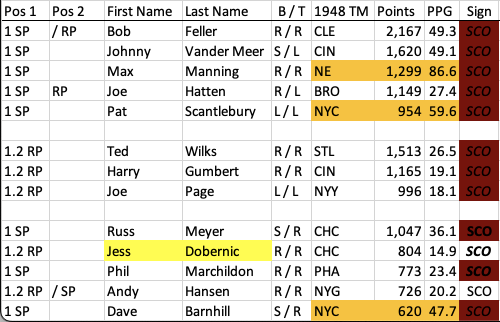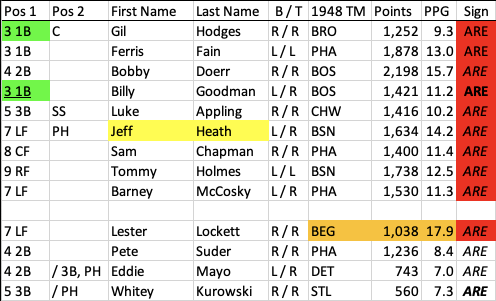1948 Fantasy Astrology Recap
View the 1948 FABL Lineups Here!
I was very excited to reach 1948 in my reverse chronological trip through baseball history, because it’s the last year with readily available Negro League statistics. I could wait to learn about the influx of amazing athletes, and add them to my All-Time Major League Astrology database, because the Negro Leagues are Major Leagues. I had grand visions of players filling in the gaps in the Fantasy Astrology lineups that arise from a 16-team MLB environment. And I had a secret hope that the new players would create a more even playing field.
Unfortunately, that last part proved not to be the case: Scorpio was again the unquestioned leader, as it turns out that many of the top Negro League stars ALSO played for the Stingers. Take Newark Eagels ace Max Manning (1,299 points / 86.6 points-per-game), who statistically outperformed all other Scorpio pitchers. That includes Hall of Famer Bob Feller (2,167 / 49.3), although the scarcity of official Negro League statistics means we only have records of 15 appearances for Manning, against Feller’s 44 games. I’ll dive deeper into the final season of the Negro Leagues in the next two weeks, but for now, here’s a look at the overall Astrology leaders from 1948.
National League MVP Stan Musial (3,352 / 21.6) leads a Scorpio lineup that includes three other 2,000-point scorers. But the most interesting thing about Scorpio in 1948 was their bullpen. In an era where few teams had dedicated closers, it seems like every bullpen ace of the era was born under Scorpio. Harry Gumbert (1,165 / 19.1) of the Reds, Ted Wilks (1,513 / 26.5) for the Cardinals, and Joe Page (996 / 18.1) on the Yankees finished tied for first, third, and fourth in the MLB in saves, respectively. In addition to the above-mentioned Manning, fellow Negro Leaguer Pat Scantlebury (954 / 59.6), of the New York Cubans, bolstered the Scorpio pitching staff, despite their much shorter seasons.
The other league leader in saves was Russ Christopher (897 / 19.9) of the MLB World Series champion Cleveland ballclub. Christopher was a Virgo, the sign that won the Earth Division… but only when ignoring positional eligibility. Ted Williams (2,876 / 21.0) was obviously the anchor of the club, but two other Indians pitchers – Negative Cy Young award winner Bob Lemon (2,576 / 59.9) and rookie Gene Bearden (2,125 / 57.4) – were the stars of the pitching staff.
On an interesting positional note, the only qualifying Virgo shortstops in 1948 played in the Negro Leagues: Tommy Butts (639 / 12.5) was a Negro National League All-Star for the Baltimore Elite Giants (pronounced EE-light), while Sam Bankhead (518 / 12.3) was on the Negro League Champion Homestead Grays. Unfortunately, even with those two Negro League shortstops (and pitcher Bill Ricks (664 / 73.8) fortifying the rotation), Virgo didn’t tally enough fantasy points to beat out Taurus when all positional eligibility rules are followed.
The 1948 Bulls were led by Cardinals outfielder Enos Slaughter (2,061 / 14.1) and Tigers lefty Hal Newhouser (2,344 / 60.1), but they also benefitted from Negro League players to fill their third base gap. Frank Russell (699 / 12.3) played primarily right field for the Elite Giants, while John Britton (307 / 10.6) was a qualified third base option from the Birmingham Black Barons.
Similarly, in the Fire Division, Aries and Sagittarius split division title honors, depending on positional eligibility. Next week, I’ll focus on how Lester Lockett (1,038 / 17.9) would have made the Rams’ starting outfield had he played a full Major League-length season. But even despite the shortness of the official Negro League seasons, Philadelphia Stars hurler Henry McHenry (664 / 41.5) would have a spot in the Aries rotation alongside Vic Raschi (1,832 / 50.9) and Emil “Dutch” Leonard (1,736 / 51.1) – not to be confused with Hubert “Dutch” Leonard (also an Aries), who pitched between 1913 and 1925.
Sagittarius also had a Negro League pitching ace in their rotation, as Bob Romby (1,029 / 64.3) of the Elites would join Johnny Schmitz (2,180 / 64.1) of the Cubs and Rex Barney (1,944 / 44.2) on the Dodgers. But the Archers just had a much stronger offensive attack: Positive MVP Joe DiMaggio (2,872 / 18.8) and third baseman Bob Elliott (2,244 / 14.9) each eclipse Aries’ top scorer, second baseman Bobby Doerr (2,198 / 15.7). Plus, there’s former Negro Leaguer Larry Doby (1,643 / 13.6) in what was technically his rookie season.
Aquarius actually has a fairly solid grasp on the 1948 Air Division, but only when Negro League pitchers Joe Black (1,350 / 79.4) and Tom Parker (708 / 78.7) join Allie Reynolds (1,568 / 40.2) of the Yankees in the rotation. If you were to count only AL/NL players (for which there is ABSOLUTELY no justification), Libra would have the lead, despite the fact that the Water Bearers had not one, but TWO Hall of Fame second basemen – Jackie Robinson (2,145 / 14.6) and Joe Gordon (2,302 / 16.0) – plus Dom DiMaggio (2,242 / 14.5), the less-heralded brother of Joe, in center field.
It's worth saying a bit about Libra, because of their twin aces in the pitching staff. Johnny Sain (2,846 / 67.8) of the Braves and Harry Brecheen (2,682 / 81.3) of the Cardinals were the two highest scoring pitchers in baseball. However, you can see from their respective points-per-game averages that Brecheen got to his total in fewer games. The Scales also had two Negro League batters who would later reach the AL/NL ranks: Jim Gilliam (835 / 14.4) had a long career with the Dodgers (both in Brooklyn and Los Angeles), while Bob Boyd (373 / 28.7) played primarily for the White Sox and the Orioles.
Next week, I’ll take a closer look at the 1948 Negro League offensive leaders, and examine who would have joined their more established AL/NL counterparts in the Astrology Baseball Classic.




